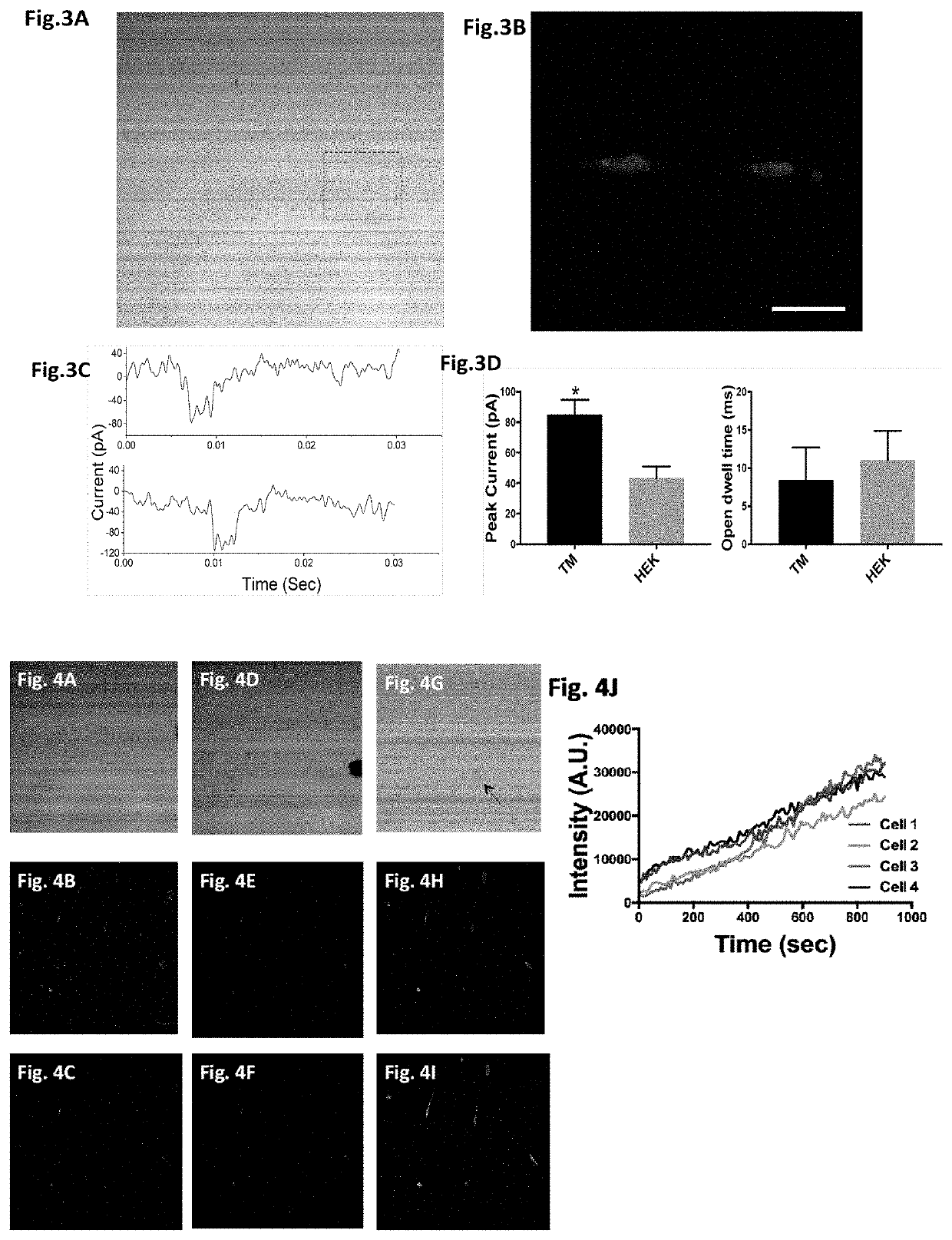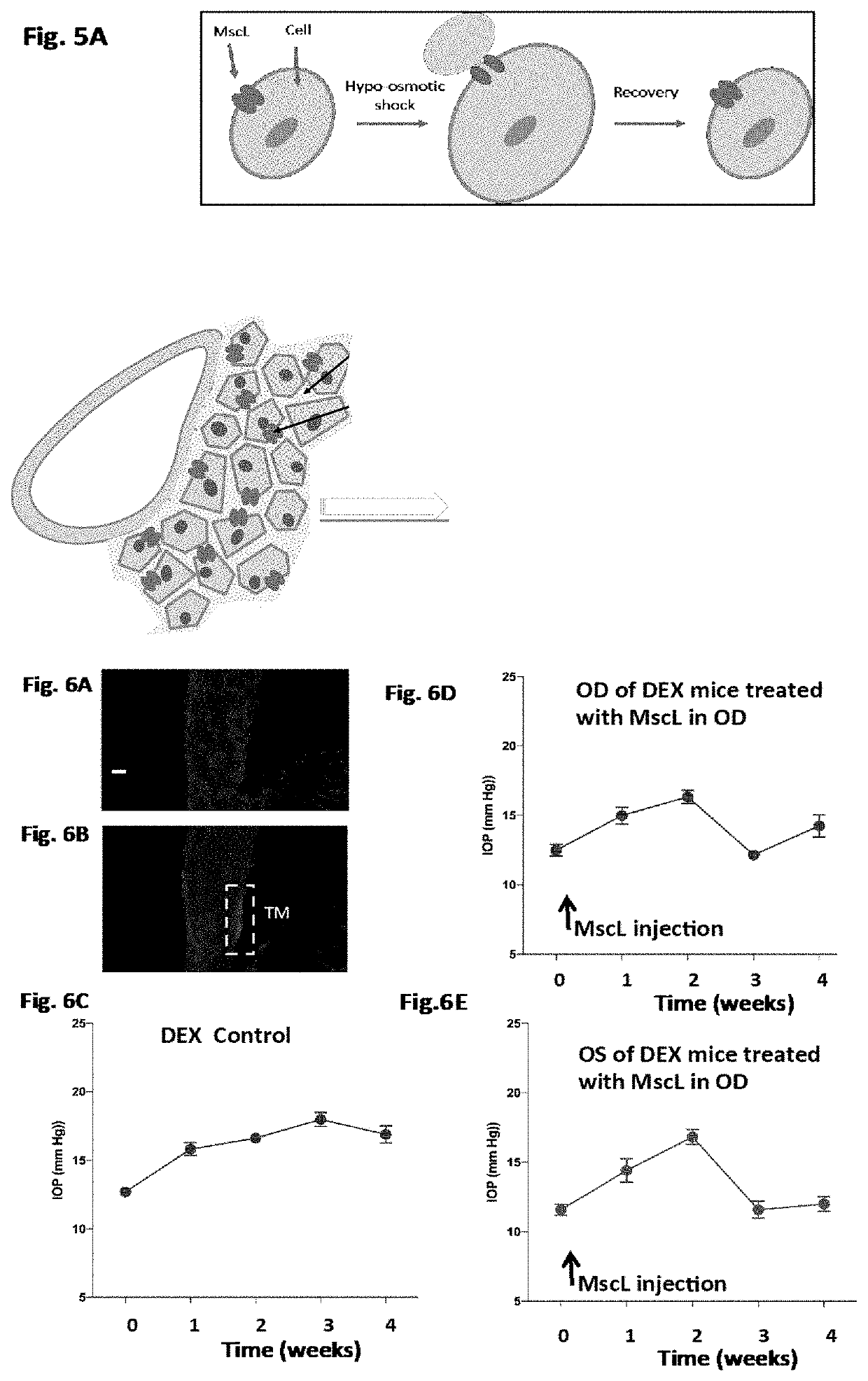Method, Compositions and Applications of Mechanosensitive Channels in Visual Disorders and Other Applications Thereof
a technology of mechanosensitive channels and compositions, applied in the field of therapeutics, can solve the problems of systemic reactions, limited clinical efficacy, and limited safety of patients, and achieve the effect of improving the secretion of the aqueous phase of tear film and alleviating the symptoms of dry eye diseas
- Summary
- Abstract
- Description
- Claims
- Application Information
AI Technical Summary
Benefits of technology
Problems solved by technology
Method used
Image
Examples
example 1
[0110]The experiments outlined below demonstrate that bacterial mechanosensitive channels can be expressed in mammalian cells, especially trabecular meshwork cells. Escherichia coli MscL (EcMscL), has been selected as a model channel because it is the most robust and well characterized mechanosensitive channel. The MscL gene from the BL21(DE3) E. coli strain, which encodes for a 136 amino acid monomer, was codon optimized for mammalian cell expression and was put under the control of a TM-specific promoter. Several studies have shown that in the eye matrix Gla protein (MGP) is preferentially expressed in TM cells and its promoter sequence has been used to target gene expression. The MGP promoter sequence (pMGP) located on chromosome 12, 14886367-14885792 was identified by using the primers from Linton et al. (2005) to run an alignment search against the reverse compliment strand of human genome GRCh38.p12. The resulting 576 bp promoter sequence was placed on the 5′ end of the EcMscL...
example 2
[0111]The experiment outlined below demonstrates that bacterial mechanosensitive channels retain their native function in mammalian cells and can be used for molecular delivery and osmotic pressure control. EcMscL is an osmoregulator and gates in response to stretching of the cell membrane caused by turgor pressure. When the EcMscL channel opens, membrane impermeable molecules are able to diffuse into and out of the cell through the open pore. Therefore, when subjected to a hypo-osmotic shock in the presence of extracellular membrane impermeable molecules (including dyes or therapeutic agents), cells expressing functional EcMscL should uptake the molecule(s). Primary cultured embryonic rat trabecular meshwork cells transfected with pMGP-EcMscL-mCherry plasmid DNA were subjected to a hypo-osmotic shock in the presence of 2 U / mL Alexa Fluor™ 488 carboxylic acid succinimidyl ester (Invitrogen) by the addition of 20% water v / v. The cells were then monitored by confocal fluorescence micr...
example 3
[0112]FIG. 5A shows the principle of the response of cells sensitized with MscL to membrane tension / deformation induced by mechanical force stimuli. The principle of controlling intraocular pressure using MscL sensitization of trabecular meshwork cells is shown in FIG. 5B. The experiment outlined below demonstrates that bacterial mechanosensitive channels retain their native functional in mammalian cells and can be stimulated by external mechanical or osmotic pressure. EcMscL channel function in mammalian cells was probed by recording electrophysiological measurements from whole cell patches of HEK293 and embryonic rat TM cells expressing EcMscL-mCherry. The patch-clamp recording setup includes an inverted Nikon fluorescence microscope (TS 100) platform using an amplifier system (Axon Multiclamp 700B, Molecular Devices). Micropipettes were pulled using a two-stage pipette puller (Narshinghe) to attain resistance of 3 to 5 MΩ when filled with a solution containing (in mM) 130 K-Gluoc...
PUM
| Property | Measurement | Unit |
|---|---|---|
| non-physiological pressures | aaaaa | aaaaa |
| intracranial pressure | aaaaa | aaaaa |
| Frequency | aaaaa | aaaaa |
Abstract
Description
Claims
Application Information
 Login to View More
Login to View More - R&D
- Intellectual Property
- Life Sciences
- Materials
- Tech Scout
- Unparalleled Data Quality
- Higher Quality Content
- 60% Fewer Hallucinations
Browse by: Latest US Patents, China's latest patents, Technical Efficacy Thesaurus, Application Domain, Technology Topic, Popular Technical Reports.
© 2025 PatSnap. All rights reserved.Legal|Privacy policy|Modern Slavery Act Transparency Statement|Sitemap|About US| Contact US: help@patsnap.com



